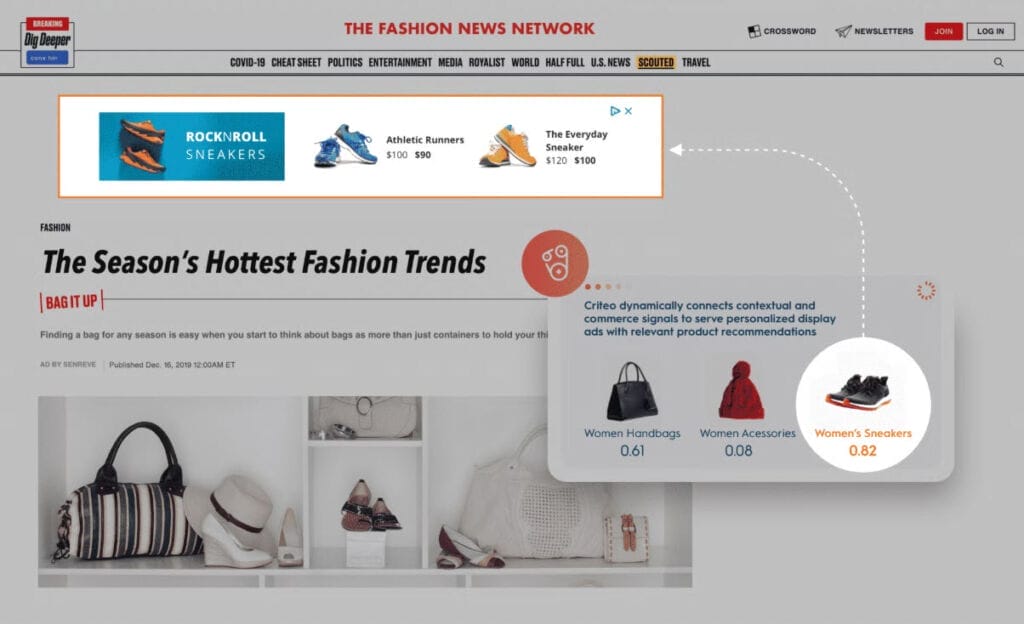When it comes to marketing on the internet, display advertising is one of the most efficient ways of capturing the attention of prospects. Display ads range from illustrated banners to animated media, and as the name suggests, they are used to grab the attention of users on websites, social media, apps, etc. It is important to understand the kinds of display ads available in the market so you can develop effective campaigns to improve your website traffic, raise brand popularity, and generate valuable leads.
What is display advertising?
Sometimes called display marketing, display advertising involves showcasing and promoting a company’s brand, product, or service through modern advertising techniques across the internet. Display ads are often a text and picture combination, and their main goal is to get the attention of users for them to take the desired action.
Display advertising captures users with compelling messages, stunning graphics, and strategic ad placement to muster interest to take action with ads. Some people can confuse display advertising for search advertising. The former is categorized under outbound marketing as it shows ads to users regardless of whether they are looking for something, while the latter uses an inbound strategy and only shows ads when a person is searching for them.
Illustrative banners and sponsored video content are some of the modern techniques of display advertising. Pop-up ads and banner ads are great examples of display ads. These ad types enable an engaging interaction between advertisers and users.
What are the most common display ad sizes?
The most common display ad sizes were:
Medium rectangle 300 x 250 px
Leaderboard 728 x 90 px
Wide skyscraper 160 x 600 px
Large rectangle 300 x 600 px
Mobile leaderboard 320 x 50
As IAB (Interactive Advertising Bureau), which develops standards for online advertising, has suggested shifting towards universal ad units that are adaptable to different screen sizes and responsive websites, they are now recommended. These are based on aspect ratio and size range.
Types of display advertising
The following types of display ads can be used to improve your brand’s online presence, engagement, and market reach, as well as facilitate audience targeting during strategizing or planning digital advertising and marketing campaigns.
1. Banner Advertising

Banner advertising is among the most popular forms of advertising that one can learn about. These ads are offered on blogs, social media, business and news websites, and on most online forums. Their shapes and sizes are generally standard; marketers can use banners in square, skyscraper and landscape sizes. Usually, banner ads show text and images to the audience so as to capture their attention.
2. Native Advertising

Video, film and text content are also considered during the strategizing process, whereby marketers use native ads as part of content marketing. Native advertisements fit seamlessly with other elements displayed on a web page, website, or email. Marketing professionals blend native ads into content in such a way that the audience perceives the ad as part of the content or brand. A few examples of native display advertisements include links directing users to other regions of a site, recommended sponsored social media content, and advertising promoted search engine result pages.
3. Interstitial display ads

Today, we see interstitial display advertisements in mobile games, social media apps, and other mobile applications. Display advertisements are shown at important transitional phases of user interactions with the app. In mobile gaming applications, interstitial display advertisements are shown between scenes or levels of games as users transition from one part of the game to another. If your marketing strategy involves mobile technologies, using mobile interstitial display advertisements can help market the products of the company you work for.
4. Video advertisements
One of the best engaging advertisement techniques is through video ads integrated into websites, social media platforms, and apps. A display advertisement with video includes captivating visual content to communicate a striking message or narrative effortlessly. These types of ads may also feature sound to amplify the visuals. Typically, this type of advertisement will show a short film with text that tells the viewer to take action by clicking on the advertisement.
Additional information about the company is available on their website. The listener or viewer can pay attention to an ad if it has animations and scrolling text. However, despite the animations and scrolling text, it’s crucial to stay focused and concise. This is important as not all viewers will finish watching the ad. Marketers view the initial moments of video ads as crucial. As noted, 36% of marketers proclaim that getting viewers’ focus during those initial few seconds is what matters the most.
5. Rich media display ads
These ads use audio, video, or other elements, allowing users to fully engage with the ad. Unlike static ads, rich media ads include more than just texts and images. Rich media ads include display video ads and other types of video commercials.
Because rich media ads encourage active participation from your audience, you can use them to:
- Differentiate from your competitors that still rely on static ads.
- Capture the interest of users as they surf through the internet, ultimately boosting user engagement on the site.
- Achieve a higher view count.
For instance, you can capture a video of a consumer engaging with one of your products and make it into a rich media display ad. The advertisement can also be designed with scroll and slide capabilities that allow the reader to use their mouse to interact with the video.
6. Pop-up Ads
Business and brand advertising on websites is achieved by means of pop-up display ads, where a pop-up content feature is utilized to invite users to subscribe, sign up, or make a purchase. Usually, pop-ups appear on a website in the form of a closed square box that elicits a desired response from users.

For example, an online service provider may wish to market its offerings using pop-ups that engage potential customers by encouraging them to learn more about its offerings by signing up with email subscriptions. Here, the brand makes the pop-up ad display when users linger on the site for a few seconds, encouraging audiences to sign up for email newsletters.
7. Contextual Display Ads
Advertising with contextual placements is when display ads appear on the pages of websites that relate to the advertised product or service. It takes into account the content and keywords of the website to provide tailor-made experiences to the users.

For example, a person browsing a fitness site can view contextual display ads about new training shoes. Unlike behavioral advertising, contextual advertising does not utilize cookies to monitor user data. It instead enables targeting consumers who use browsers that do not allow the collection of third-party data.
8. Retargeting Display Ads
These are advertising strategies that specifically focus on people who are already familiar with a certain product or service. For instance, think about a scenario where a user browses through a company’s online shop on Google and decides to close the tab. The user may come across an ad template for that same company on another unrelated website days later. This type of ad targets people who have already interacted with their product or service.
Often this technology was made possible by tracking users through cookies, which are small files storing data that you drop from your website onto a user’s browser — allowing your ads to follow that user across different advertising networks. As stricter privacy measures are adopted globally, many brands are adopting different approaches, such as server-side tagging.
Benefits of Display Advertising
Display advertising comes with several benefits. Among other things, display advertising helps businesses to:
- Increase brand awareness: You can reach a broad audience with display advertising. Widespread exposure helps raise brand awareness and visibility among potential customers.
- Target customers: With display advertising, advertisers can laser-target their audiences using demographics, geography, behavior, and other factors, which ensures ads are served to the relevant users.
- Design a complete funnel campaign: With programmatic advertising and smart bidding, advertisers can create and refine their campaigns using multiple ad buys to capture customers at different levels of the sales funnel.
- Multiple ad formats: Display advertising includes banners, pop-ups, pop-unders, wallpaper ads, interstitial ads, map ads, video ads, etc. Advertisers can pick the most relevant format to serve users and grab their attention.
- Retarget audience: Advertisers can retarget customers by serving ads to users who have interacted with their brand before when they are browsing other websites or platforms.
- Evaluate Results: Display advertising offers sophisticated measurement and analytics tools that allow for tracking reach, click-through rate, rate of recurring visits, conversion ratio, ROTI, and other essential parameters. These insights enable advertisers to make data-driven optimizations for their campaigns through effective evaluation.
Obstacles Confronting Display Advertising
Despite its advantages, display advertising tends to create some challenges that can hurt its effectiveness. Among these struggles, limited visibility caused by ad blockers, low CTR (about 0.1%) caused by banner blindness, and random mobile clicks dominate.
Advertisers need to manage a lot of controllable pitfalls, like poor targeting that leads to inefficient ad placements and ineffective creative strategies aimed at engaging the audience. Strategically overcoming these issues can increase the efficacy and impact of display advertising campaigns.
Display Advertising Recommended Procedures
1. Set definite goals: As long as your objectives are clear, it does not matter whether your campaign relates to brand awareness, leads, or sales. Being clear with your objectives will guide you towards the best implementation of your strategy and measuring results.
2. Striking Graphics: Make clever and creative banner advertisements for your website. Ensure that powerful images, colors, and fonts that are appropriate for your brand are applied. The “stopping power” or the ability of a striking ad to capture attention is more important than sheer attention-getting ability. Get is a globally funded organization that assists people and institutions owing to natural disasters and economic breakdowns.
3. Inclusive and Effective Copy: The advertising copy has to be compact and powerful; capture brevity and impact simultaneously. Use convincing words and spotlight the main benefit to communicate alongside a bold CTA.
4. Cross-Device Compatibility: Ensure accuracy and complete responsiveness of your display ads on all devices and screen sizes. Improved user experience However, responsive design ensures a uniform, engaging appearance across desktops, tablets, and other mobile devices.
Conclusion
As we saw in the digital marketing strategies, display advertising services remain one of the most important components of any contemporary marketing plan. It enables marketers to reach their target audience in a highly visual and engaging manner. Different formats like banner ads, videos, and interactive as well as native ads offer unparalleled flexibility, which marketers can adapt to their different sales objectives. Whether businesses wish to increase their brand visibility, retarget potential clients, or increase direct sales, display advertising can be customized to achieve the desired outcomes.
In a highly competitive digital market, display advertising does not only improve the chances that clients will notice your business but also lets marketers interact with their audience in a more profound way. Companies can tailor their marketing campaigns to meet user needs and expectations through various advertising techniques. Thus, it is essential that present-day marketers pay attention to this versatile tool.

